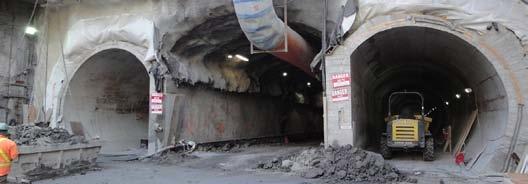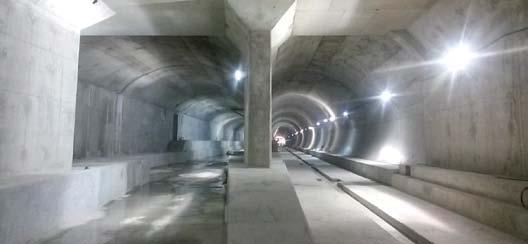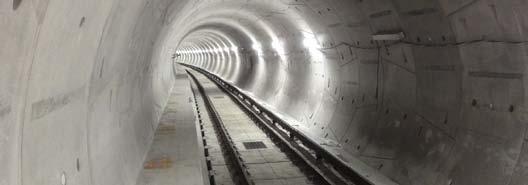
6 minute read
TTC: Toronto Transit Commission
A NEW LIFELINE TTC: Toronto Transit Commission
With a history of offering Toronto easy and reliable transportation solutions, the Toronto Transit Commission has embarked on one of its most ambitious projects yet; the Toronto-York Spadina Subway Extension. Endeavour Magazine took a closer look at the project, to establish how and why this will prove to be a whole new lifeline for the residents of the area.
The Toronto Transit Commission (TTC) has long been in place, overseeing the installation of reliable infrastructure and ensuring future-proofed transportation solutions, but the extent to which it is attempting to make customer satisfaction the chief priority is simply staggering.
Alongside continuously upgrading facilities, such as stations and maintaining subway trains, a huge project has been undertaken, which is now nearing completion, but with exceptional facilities already in place, what could Toronto possibly need?
“The Toronto-York Spadina Subway Extension Project will provide a critical extension for the existing Toronto Transit Commission subway system across the municipal boundary between the City of Toronto and The Regional Municipality of York (York Region).”
Adding an extra 8.6-km of subway line means that this is an innovative, as well as exciting, development, as this will be the very first time that the TTC has built a rapid transit line that physically crosses the Toronto City boundary.
It’s no secret that as populations grow, cities develop, expand and need to cater to the needs of every resident and by taking Endeavour Magazine | 67
the initiative to add the Line 1 extension into York Region, the TTC is committing to always being one step ahead of what the city needs. If only all transport infrastructure operations could take a similar approach! Just imagine not having to get stuck in rush hour traffic on a daily basis and you’ll see that there are lessons to be learned from this methodology.
Adding six stations to the extension, customers will have easy access to a jumping on or off point, wherever they are located and a planned service schedule of a train every four minutes means that being late will never be an option again. If you’re thinking that it will be difficult to encourage people to use the new train services, as apposed to regular cars, however, think again, as the TTC has accounted for that,
“To encourage commuters to use the subway system, 2,900 parking spaces are planned for various stations. Commuter parking lots are planned at the Finch West Station with 400
spaces, Pioneer Village Station with 1,850 spaces, and Highway 407 Station with 563 spaces.”
In an ideal world, nobody would need encouragement to take a greener, more economically sound method of transportation, but the TTC has an inherent understanding of the fact that convenience will always win out, hence the fantastically frequent train schedule and easy access to cost-effective parking, but there is always scope for further improvement. “On opening day, trains will run every four to five minutes. As more people use the subway, trains will be added and become more frequent.”
Naturally, the question on everyone’s lips is when will this fantastic extension be completed and ready to use, given that it gained initial environmental approval in 2007?
“Service on the new extension is planned to start at the end of 2017. So you can expect to catch a train northbound from the existing Downsview Station (to be renamed Sheppard West on May 7, 2017) all the way to the Vaughan Metropolitan Centre at Highway 7 and Jane Street. The new Toronto Rocket trains run on the Line 1 Yonge-University subway. The TTC has replaced the entire Line 1 fleet with newer and more comfortable ‘Toronto Rocket’ (TR) trains and has acquired additional TR trains for the Toronto-York Spadina Subway Extension. It will take approximately 14 minutes to travel from the current Downsview Station (soon to be Sheppard West) to the end of the line at Vaughan Metropolitan Centre (VMC) Station.” If you’re thinking that 10 years seems like a long time to add 8.6-km, you need to think about the bigger picture. New subway tunnels were required and that is no small undertaking. “The three main techniques used to build the subway extension are tunnel boring, ‘cut and cover’ construction and sequential excavation method (SEM). SEM was used to build a Double Ended Pocket Track Housing Structure (DEPTHS) under the Finch Hydro corridor. Depending on soil conditions, an earth pressure balance tunnel-boring machine can progress approximately 15 metres per day.”

15 metres a day? No wonder this was always going to be a long-term development, but with the tunnels now finished, other aspects can be focused on, in order to bring the project to completion.
“Construction of the subway tunnels was completed in November 2013. Four tunnel boring machines, Holey, Moley and Yorkie, Torkie, drilled 6.4-km of twin tunnels. Construction work on all six new stations is well underway and you can now see the entrances and bus terminal structures rising above the ground.”
Promising to significantly improve the lives of Toronto and York Region residents, essentially, this is a priceless and invaluable endeavour, but as with any commercial project, there is a definitive price tag attached. Coming in at $3.18 billion, it’s no joke to say that transport infrastructure is big business, but a number of governments have come together to invest,
“The Toronto-York Spadina Subway Extension project is jointly funded by the Government of Canada, the Province of Ontario, the City of Toronto and The Regional Municipality of York. The Government of Canada has committed $697 million, the Province of Ontario has provided $974 million, which has been deposited into the Move Ontario Trust and the City of Toronto and The Regional Municipality of York have committed to fund one-third of total project costs. Toronto will contribute $907 million and York Region will contribute $606 million.”
Such collaborative working is exactly why Toronto and outlying regions will continue to enjoy seamless transportation infrastructure and future-proofed accessibility solutions. The TTC has and will continue to rise to the needs and wants of the people that it serves and we look forward to observing what a positive impact the TorontoYork Spadina Subway Extension project will have.
AECON: BUILDING A BETTER WAY

For more than a century, Aecon has been a Toronto | GTA partner-of-choice for critical infrastructure builds. Proudly meeting the complex needs of the Toronto Transit Commission (TTC) in the design and construction of subway tunnels, rapid transit systems, platforms, instrumentation and controls, as well as state-of-the-art stations like the new Downsview Station on the Toronto-York Spadina Subway Extension Project.
Obrascon Huarte Lain (OHL) is a concessions and construction group with more than 100 years of history and an international leader in the construction of hospitals and railways. www.ohlcanada.com

FCC Construction is the infrastructure division of FCC Group, an international leader in environmental services, infrastructure and water management with over 100 years of experience. www.fccco.com
OHL & FCC have partnered together to construct the Highway 407 Station and the Northern Tunnels, as part of the Toronto York Spadina Subway Extension, for which they were awarded the “2015 Major Infrastructure (Canadian) Project of the Year”















